Many uses for a blue light
This week: Visualisation; What to do on a Sunday?; Many uses for a blue light; Mechanical failures; Looking up; Use all the available space;

I’ve had a couple of trips to the builders merchants this week, to get materials to start the “fitting out” process for the new build. I’ve measured everything, then drawn the plans and made a start.
It has been helped by some really nice weather and we have had our first 20ºC degree days this year.
Although I have found that the covered gap between the old and new build is quite a wind tunnel, even when there is just the slightest amount of air movement.
I had already planned on putting a gate across, but I will also put a high level window too, so that sunlight can still get into the covered yard.
One strange thing I noticed this week is that my Almond tree has burst into leaf, completely missing the blossom stage.
It is one of my indicator species for my Springwatch Calendar, so I have been looking out for blossom. Other trees in the village have also been lacking flowers too.
Almonds need winter cooling when the buds are forming and I wonder whether the warm winter and lack of cold nights has affected it and the others?
There are so many of these effects caused by climate change that we just don’t realise how extensive and disrupting it is and will be in years to come.
Visualisation
My friend and Master Stonemason called in to look at the walls which need rendering in the new building.
One wall is the original stone wall of the Donkey stable. The floor was half a meter lower than the new floor, so the square holes in the old wall are where the tree trunk beams rested. It was these locally sourced behemoths that held up the hay loft floor above the stalls.

Cvjetko asked me why I wanted to cover this wall in render. I really didn’t have an answer. Unlike some of my other walls, this one has a lot of nice, even stonework. It is also pretty much vertical – again unusual.
The mortar between the stones is the original lime mortar from the 19th century and being protected by the stable and hayloft, it is generally in good condition.
The lower half of the wall which is reinforced concrete – to hold it up – will be hidden by my work bench.
His question did make me think though.
I have visualised every part of my home, being able to see, without even closing my eyes, what it will eventually look like.
Over time, from before I had even purchased the property, I had sketched how I wanted it to look.
The complicated issues around getting permission to build and make alterations have delayed things, because I insisted everything had to be legal first.
But I had thought of expedience, quickly rendering the inside walls, over the beauty of the old stones.
Given the history of the building and this part of it, as I looked at the blank wall this week, I realised Cvjetko was right and the stones should be left bare.
Some cleaning will be required and I will have to order some specialist tools, for example Quirks, to properly remove any decaying lime mortar, but I think when finished it will look the part, and it will preserve a little more of the building’s history.
As for the beam holes, they will stay as a bit of extra storage and somewhere for the geckos and tarantellas to live in peace.
What to do on a Sunday?
I have a home inventory system, it’s not necessarily the best, but it works for me.
Everything that is in a storage box is listed on a spreadsheet, with the location where it is stored. There are still quite a few things that came with me from Abu Dhabi, which because of a lack of space issues, mean they are still in their boxes.
As the sun climbs higher in the sky every day, and with my bench seat repaired and in place on my new terrace, there is a temptation to just sit and enjoy the warm sun and the nature which surrounds the terrace.
However, with a long list of jobs for the next week, I try not to succumb to temptation too often.
Sundays are “quiet” days, when using noisy machinery is frowned upon, this is in deference to religious norms rather than any municipal diktat.
So not wishing to upset any local sensitivities, I try to conform to the expectations. This of course means that either option a) Do nothing or option b) Work, but don’t use machines applies. I usually go for option b).
This week I remembered that I had a nice hammock which is in a box some where. Very soon afternoon siestas will become mandatory so I looked on my spreadsheet and found where it was stored.
A quick visual check confirmed the box was right at the back of the small workshop.
It is also time to start spring cleaning. The dust from the wood stove, together with dust from the building work and the ever present sand in the courtyard, mean that it is time for a good cleanup.
I’ve had a number of boxes in the dining room over the winter and I reasoned that if I extracted the hammock box, I would free up storage space to enable a move and freeing of space in the dining room.
Pulling the boxes out, I discovered that there was a damp patch on the back wall.
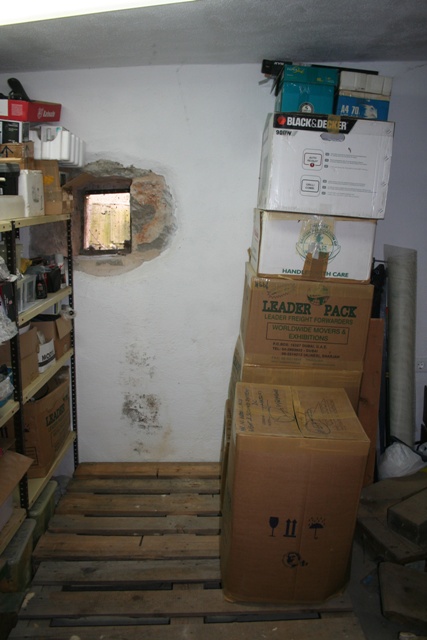
This is below ground level outside and the box was leaning up against and in contact with the wall.
Before replacing the boxes, I lined the wall with a piece of plastic. This room will have a change of use when the new workshop comes on line, and will need to be painted, so I’m not worried about the wall “sweating” behind he plastic.
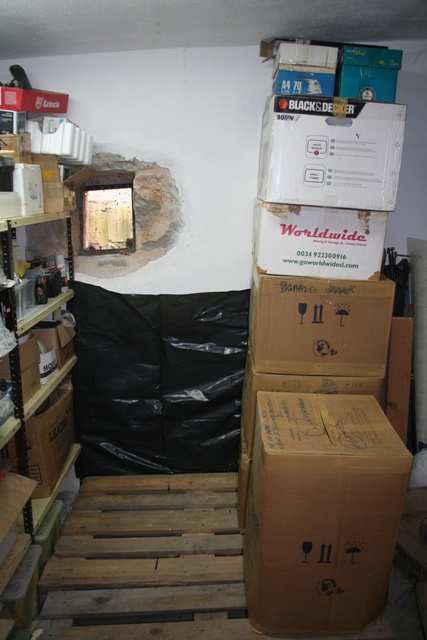
I replaced everything, moved things down from the dining room, then on Monday erected the hammock and put it onto the terrace.
It will stay here for the summer. In another store I have a nice parasol, but it is much deeper in so more difficult to access.
However I can still imagine a fine summer evening being enjoyed on the terrace with a glass of the local Rosé in hand.
Many uses for a blue light
It was not long after last week’s blog was published that I received a message about magnets.
One of my retired colleagues remarked that it was a shame I hadn’t kept a “Kojak” light from my time in the emergency services.
He went on to recount how the substantial magnetic base of his had recovered keys from a drain and found other lost items.
I immediately remembered that I did indeed have a “Kojak” light, I just needed to find it. I knew it was in the box marked “Light and sounds systems” and I had seen the box in the small store last weekend.

It’s funny how decades after TV series, terms remain in common use.
Lt Theo Kojak was a tough, lollipop sucking New York City Police detective played by Telly Savalas. The series only ran from 1973 to 1978 but in that time it gained a cult following.
Being a detective, Lt Kojak had an unmarked car, but to get anywhere in an emergency he had a red Federal Signal “teardrop” magnetic light that he simply plonked onto the roof of his car.
These and indeed all magnetic emergency lights rapidly became known as “Kojak lights”.
And this is what they are still known as today, forty years after the TV series ended and when most present day users will have no idea who Lt Kojak was.
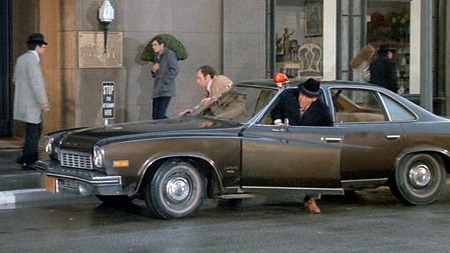
It didn’t take long to find the light, unscrew the magnetic base and then with a handle made from string, to sweep the courtyard magnetically.
Just exactly what I was thinking of last week, but I had in mind making a simple electro magnet from a soft iron core, some magnet wire and a small battery. This ready made version was a much simpler and quicker option!
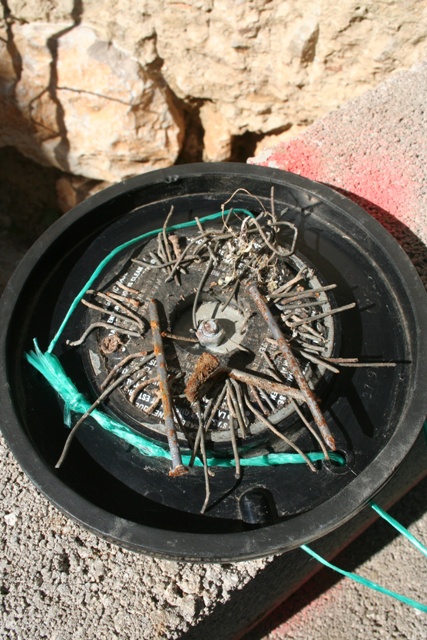
Thank you Superintendent H for the idea – it worked!
As an aside, I have met Telly Savalas and his brother George, who played the part of Detective Stavros in the series several times.
His mother was a well known local artist and painter who lived in the village of North Ferriby, which was part of my patrol area.
I invited Telly to some police functions in the UK, which he came to if he was in the UK.
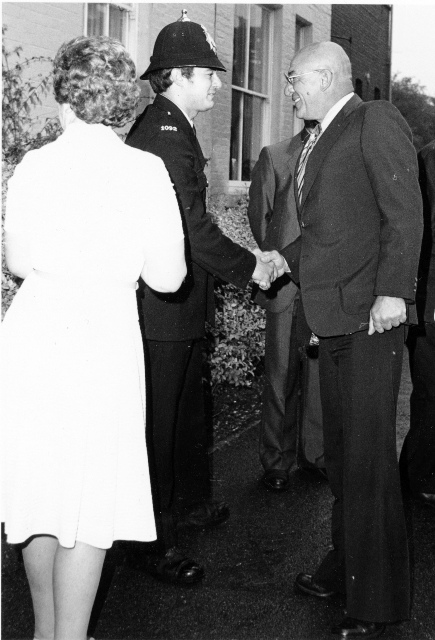
At one function he was presented with a UK police helmet. He was just as polite and suave in person as he was on screen.
Mechanical failures
This week the European Union has announced plans to legally require manufactures to make appliances repairable. Unfortunately the regulations are not going to be backdated…
These new regulations will apply in the main to things like Tablets and mobile phones.
But there are still issues with other electrical items which break and have passed their built-in obsolescence date.
I have had a problem with my Canon Powershot SX280 camera this week. I took it out of its pouch to use, pressed the power button and was surprised when the lens protection iris only half retracted.
Rather than force it, I powered the camera down and came home.
A blast with compressed air has failed to clear what ever it is that is blocking the mechanics of the iris.
The camera is well outside its warranty and is basically unusable. Finding a local repairer is a non starter so it looks as though I am going to have to dismantle the camera myself.
This should of course be done in “clean room” conditions to prevent any dust or contamination getting to the CMOS sensor. I don’t have anywhere remotely clean enough so will have to think how I can accomplish the repair.
At least there are several on-line tutorials to guide me about how to dismantle, clean and reassemble the camera.
I hate throwing away perfectly good electronics for want of a repair, but this particular task is a fair way down my “To Do” list at the moment.
Looking up
I started by asking the friendly staff at Volat what I should use to seal a new concrete ceiling. A product called Ceresit CN95 was the answer.

Ceresit is part of the German company Henkel who are headquartered in Düsseldorf. The origins of Ceresit go back to the company’s formation in 1905 and the introduction of the world’s first cement insulation mortar in 1910.
Today they supply specialist materials on five continents. This is good because it means I can buy a Ceresit product in my local builders merchants, with the label in almost unintelligible Slavic languages, then immediately go on line and get the complete data sheets and instructions for the product in English.
New concrete needs sealing and CN95 is water soluble, so I mixed the whole 1 litre bottle with three litres of warm water and started painting the ceiling of the covered yard.
The covered yard has a surface area of over 11 m² so it was just a couple of hours work to paint it all by hand.
For ceilings I only use a wide brush. I have never found ceiling rollers to be much use, especially where you have a very runny, water based sealant to apply.
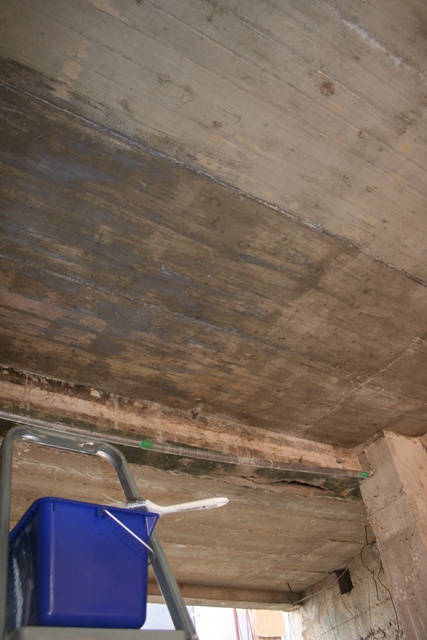
Applying the sealant changed the colour of the concrete, so it was easy to make sure no bits were missed.
After 24 hours I applied the first coat of Jotun white exterior grade paint. This is from one of several 25 litre drums of paint that came with me from Abu Dhabi.
I have about a third of the contents of this drum left and after mixing with an electric paddle, the paint was smooth and was easy to apply.
Following a further 24 hours to let the first coat dry, I gave the ceiling a second coat of paint, which nicely covered the whole area.

Use all the available space
There are several ladders of different lengths that are dotted around in various stores, or in the case of my aluminium extending ladder, outside the summer kitchen. All are easily accessible, but they take up space.
Although I want to clear the big Konoba, ready for it to be turned into living space, I can’t do much until the new workshop is finished inside.
One of the things which I also store in the big Konoba is my timber. I don’t buy in bulk per se, but when I need one 4 metre length of Kantonela, I will buy four or five at the same time so I always have some in stock.
Once stock levels of particular items are reduced, I will buy more. There are also the over-runs of things like the hardwood flooring I used for the study and bedrooms.
Timber takes up a lot of usable space too.
What I have decided to do is to make a ceiling rack for both the ladders and the long lengths of timber and to store them in the covered courtyard. I need to use all the available space that I have.
With a ceiling height above finished floor level of almost three metres, I can afford to reduce this height by a half meter. So based on that measurement I drew a sketch of how I can maximise the available space but with a simple design.
The largest timber profiles I have in the store are nominally 8 x 5, however this is, or was green timber. After a year in storage it is seasoned, but is rough.
I will use these as the uprights, bolted to the ceiling with threaded bar running between to support the load.
At the end of the week, I ran lengths of the 8 x 5 through my thicknesser, so I have planed straight edge (PSE) timber. You get the lovely smell of a carpenters workshop when running these big wood working machines.
This has reduced the actual profile from the approximate 8 x 5 to 7.5 x 4.5, but I now have usable timber. Next job was cutting the lengths to size with a mitre saw.

Working from the plan, I measured where the threaded bar would go and brought out a small drill press to cut nice, even holes. But this is where my work ground to a halt.
The threaded bar is 12 mm, and when I put my 12 mm wood boring bit into the drill and started it, I saw the bit was oscillating. I removed it and re-seated it in the drill chuck, in case I had not got it square, but on re starting the drill, the sideways oscillation was still there.
The bit has become bent, probably when I last used it to bore some non critical holes in old ceiling beams.
So that was where my work came to an end for the week.
Do it once and do it right is my motto, and I don’t want oversized holes, even if they are only a couple of millimetres out of true.
As it was already 1pm, and the builders merchants all close at 12:30 on a Saturday, I am stuck until next week.
But you can be assured that first thing on Monday, I’ll be in the town to buy my next lot of supplies. NRC
5 Responses
BrianHomans
Enjoyable read as ever, Norman. Not my business, but I also agree with leaving the stone wall natural, and not rendering it.
Michael
Norman,
to get your Canon 280 fixed send it to Johnstone’s in Glasgow: they’re absolutely marvellous.
Website: https://www.ajjohnstone.co.uk/our-location
Terry H
I am pleased that I still have my uses Norman. As you know I loved improvisation. Best wishes.
Tony Griggs
Agree about leaving the stoke wall natural Norman! Yeah, those magnetic lights were good. I’ve got an amber one for when I used to be able to access the city airport to load my equipment from the car onto the plane. Still got it!
Elizabeth B
Hi Norman – I too agree with leaving the wall bare. It is lovely to keep some reference to the age of a place visible and, as you say, those beam holes are just right as little storage nooks. Didn’t realise that Tele Savalas had a local connection. We never missed that programme in our house! We have a tiny little Fuji, which has always taken good little phots and is a useful little thing but has decided not to work. I think we will be contacting Johnstone to see if they can get it working again for us. Love your news, as always. Take care.